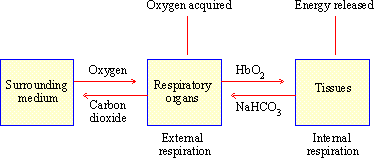|
CHAPTER 17 : RESPIRATION
17.0 Introduction
All organisms, without exception,
require energy for sustaining life activities. Respiration is an energy
releasing process. It is defined as biological oxidation in
which stored food is broken down step by step to release metabolically
usable energy, giving out CO2
and water vapor as by-products. It goes on in all living cells
at every moment of their existence as living entities.
Physiologists distinguish respiration into external
and internal respiration.

Figure 17.0 Respiration
(1) External respiration or breathing: It
involves the exchange of gases between surrounding medium and blood
circulating in the respiratory organs. It is a physical process
in which free oxygen is acquired by the animal. It neither involves
oxidation nor release of energy.
(2) Internal respiration or cellular respiration:
It takes place in the cells during which the food is oxidized and
energy is released. Biological oxidation is not the process of direct
oxidation, but a complex oxidation-reduction process is brought
about by a series of respiratory enzymes and coenzymes
present in the mitochondria. The overall reaction is as follows:
respiratory enzymes
C6H12O6 + 6O2------------------> 6CO2+ 6H2O + energy
| 